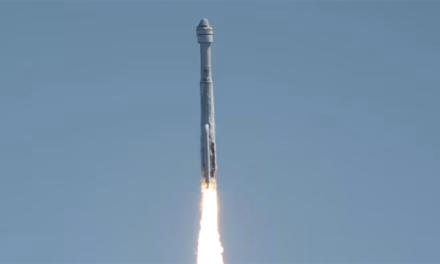NASA’s Juno probe has flown closer to Jupiter and the largest moon in our solar system, Ganymede, than any spacecraft in more than two decades. Using the spacecraft’s JunoCam imager, the mission team has put together this animation to provide a “starship captain” point of view of each flyby.
Credits: NASA/JPL-Caltech/SwRI/MSSS



“The animation shows just how beautiful deep space exploration can be,” said Scott Bolton, principal investigator for Juno from the Southwest Research Institute in San Antonio. “The animation is a way for people to imagine exploring our solar system firsthand by seeing what it would be like to be orbiting Jupiter and flying past one of its icy moons. Today, as we approach the exciting prospect of humans being able to visit space in orbit around Earth, this propels our imagination decades into the future, when humans will be visiting the alien worlds in our solar system.”
NASA is celebrating the achievement by giving away free psychedelic posters. Get yours here.

The 3:30-minute-long animation begins with Juno approaching Ganymede, passing within 645 miles (1,038 kilometers) of the surface at a relative velocity of 41,600 mph (67,000 kph). The imagery shows several of the moon’s dark and light regions (darker regions are believed to result from ice sublimating into the surrounding vacuum, leaving behind darkened residue) as well as the crater Tros, which is among the largest and brightest crater scars on Ganymede.
It takes less than 15 hours for Juno to travel the 735,000 miles (1.18 million kilometers) between Ganymede and Jupiter, and the viewer is transported to within just 2,100 miles (3,400 kilometers) above Jupiter’s spectacular cloud tops. By that point, Jupiter’s powerful gravity has accelerated the spacecraft to almost 130,000 mph (210,000 kph) relative to the giant planet.
NASA’s animation team also simulated lightning that would be visible if you were actually viewing one of Jupiter’s thunderstorms in person. The camera’s point of view for the animation was generated by citizen scientist Gerald Eichstädt, using composite images of the planet and its moon. Here’s more of his work:

As planned, the gravitational pull of the giant moon has affected Juno’s orbit, resulting in the reduction of its orbital period from 53 days to 43 days. The next flyby of Jupiter, the 35th of the mission, is scheduled for July 21. More images then!
-30-
![]()
David Raiklen wrote, directed and scored his first film at age 9. He began studying keyboard and composing at age 5. He attended, then taught at UCLA, USC and CalArts. Among his teachers are John Williams and Mel Powel.
He has worked for Fox, Disney and Sprint. David has received numerous awards for his work, including the 2004 American Music Center Award. Dr. Raiklen has composed music and sound design for theater (Death and the Maiden), dance (Russian Ballet), television (Sing Me a Story), cell phone (Spacey Movie), museums (Museum of Tolerance), concert (Violin Sonata ), and film (Appalachian Trail).
His compositions have been performed at the Hollywood Bowl and the first Disney Hall. David Raiken is also host of a successful radio program, Classical Fan Club.













Wow, that was really something! Thanks for clueing us into this.